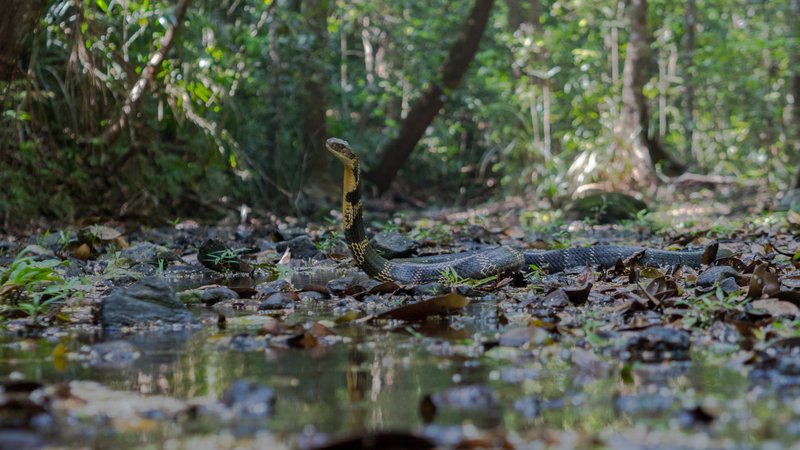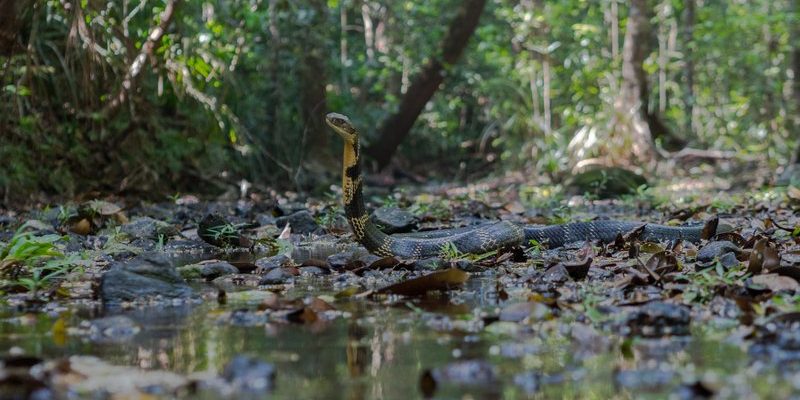
Imagine taking a journey through dense forests, lush jungles, and even along rugged coastlines. King Cobras thrive in various environments, each unique and filled with its own wonders. Understanding where these snakes live isn’t just for the curious; it’s crucial for conservation efforts. Their habitats tell us a lot about the ecosystems they help maintain and the challenges they face due to human activity. Let me explain where you can spot these majestic snakes and what their locations reveal about their behavior and survival.
Overview of King Cobra Habitats
King Cobras, scientifically known as *Ophiophagus hannah*, are primarily found in Southeast Asia, but their range extends much further. They are native to countries like India, Thailand, Malaysia, and the Philippines. These snakes are highly adaptable, which is why you might find them in a variety of environments.
They typically prefer areas that offer abundant prey and suitable shelter. This means you’re likely to spot them in forests, mangroves, and even grasslands. Interestingly, they often stay close to water bodies, as they are excellent swimmers. You could say they’re like the introverts of the snake world, preferring hidden spots where they can observe their surroundings without being disturbed.
What’s truly fascinating is their ability to thrive in human-altered habitats. You might even see them in agricultural areas or near plantations, where they hunt for rodents and other small animals. This adaptability is both a strength and a warning sign, as it highlights their resilience amid changing environments.
Geographic Distribution
When it comes to the geographic distribution of King Cobras, they cover a vast area. Predominantly, you can find them across:
- India
- Indonesia
- Thailand
- Myanmar
- Vietnam
- Malaysia
- The Philippines
- Southern China
In India, for example, King Cobras are often spotted in the Western Ghats and the northeastern states. These regions feature a mix of tropical rainforests and lush hills, perfect for these snakes. Malaysia and Indonesia are also prime locations since they boast extensive tropical jungles, which offer plenty of opportunities for these snakes to hunt and breed.
You might be wondering how they manage to live in such diverse places. Here’s the thing: their diet consists mainly of other snakes, including their own kind, which means finding habitats with a rich snake population is key. King Cobras are skilled hunters and can adapt their hunting methods based on the environment and available prey.
Habitats in Specific Countries
Now that we have a general idea of where King Cobras can be found, let’s take a closer look at specific countries and their habitats.
India
In India, King Cobras can be found in the southern and northeastern regions. They thrive in dense forests and hilly areas where there’s plenty of cover. The Western Ghats is a notable hotspot, characterized by its thick vegetation and biodiversity. The snakes can often be seen basking in the sun or hunting for food around water bodies. Interestingly, in places like Kerala, these snakes are sometimes revered and considered sacred, which adds a cultural dimension to their presence.
Thailand
Moving on to Thailand, you’ll find King Cobras in tropical forests, particularly in national parks such as Khao Yai. These areas are rich in biodiversity, making them perfect hunting grounds. They can also wander into agricultural fields, posing risks to local farmers. The diverse habitats in Thailand highlight their adaptability, as they shift from dense jungles to open rice paddies.
Indonesia
In Indonesia, King Cobras are mostly found across several islands, including Sumatra and Borneo. The lush rainforests here are teeming with wildlife, providing ample food. They’re particularly drawn to areas near rivers and swamps, where they can easily hunt for prey. The rich ecosystems of Indonesia play a crucial role in sustaining these snakes, but they also face threats from deforestation and habitat destruction.
Conservation and Threats
As mesmerizing as they are, King Cobras face various threats linked to their habitats. Factors like habitat destruction, poaching, and climate change are impacting their populations. Urban expansion and agricultural activities push them into smaller and fragmented habitats, increasing conflict with humans. This is where conservation efforts come in.
Efforts to preserve their natural habitats are vital for their survival. Wildlife organizations are working to create protected areas and engage local communities in conservation programs. Public education about the importance of King Cobras in the ecosystem is also crucial. After all, they help control the population of other snakes and maintain a balance in their environment.
It’s essential that we recognize the beauty of King Cobras and the unique ecosystems they inhabit. Protecting their habitats is not only beneficial for them but also for the health of our planet.
Final Thoughts
So, where are King Cobras found around the world? They inhabit a range of environments across Southeast Asia, including India, Thailand, Indonesia, and more. Their adaptability is impressive, but it also highlights the challenges they face due to human activities. Understanding their habitats helps us appreciate these incredible snakes and the role they play in our ecosystems.
In summary, the King Cobra isn’t just a creature of legend; it’s a vital part of the biodiversity that enriches our planet. By respecting their habitats and supporting conservation efforts, we can help ensure that future generations experience the awe of these magnificent snakes in the wild.

